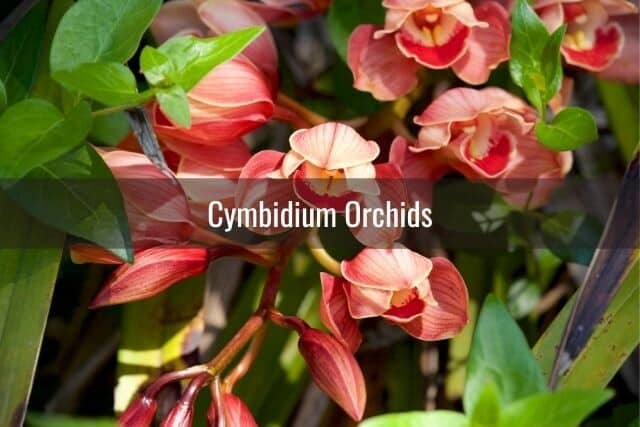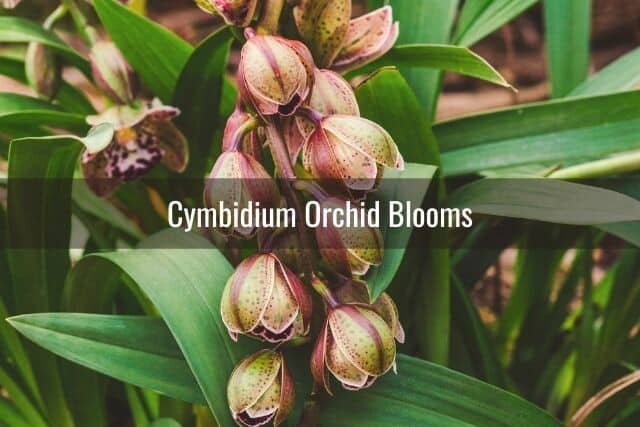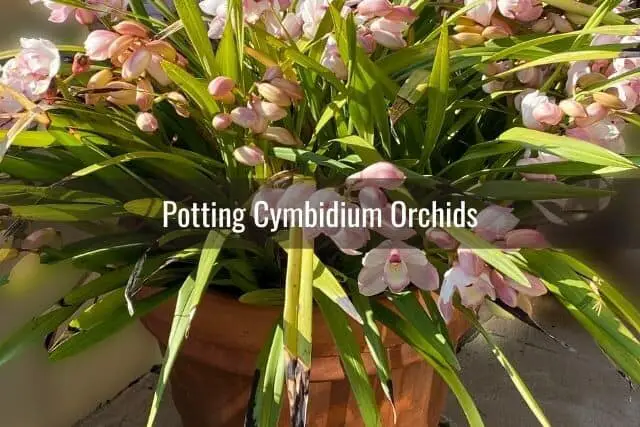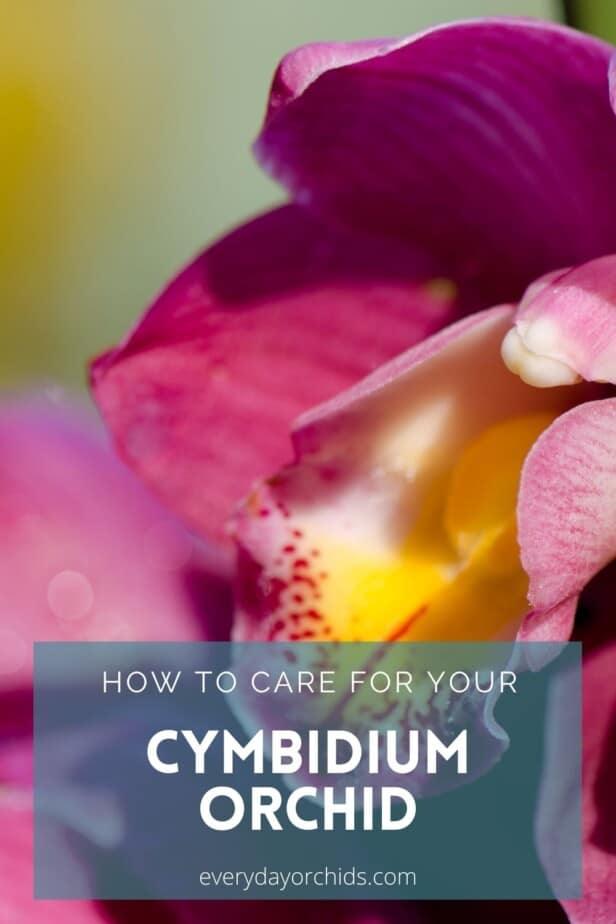Cymbidium orchids are one of the most popular terrestrial orchids available. These orchid blooms are commonly used in corsages (remember prom?). They are also often used in cut flower displays. Cymbidium orchids are relatively easy to grow and produce a multitude of large, beautiful blooms.
Are you interested in adding these to your orchid collection? Here’s some key points you need to know in order to successfully grow Cymbidium orchids in your home or garden.

Cymbidium orchids are relatively easy to care for. They require frequent watering and regular fertilization with a diluted orchid fertilizer during the growth period. These orchids can be planted outdoors and have a temperature tolerance range of 50 to 85 degrees Fahrenheit. Cymbidium orchids grow best with partial sunlight. If you live in a mild climate, these orchids can remain outdoors year-round.
Want to find out more? Keep reading to learn more about how to care for these beautiful orchids.
Please note that these links are affiliate links and as an Amazon Associate, I earn from qualifying purchases. Purchases made through affiliate links in this post may generate commissions at no additional cost to you. Use this link for a discounted Amazon Prime trial. Thank you for your support!
Table of Contents
All About Cymbidium Orchid Care

Cymbidium orchids, or “boat orchids,” are one of the most popular terrestrial orchids out there. These orchid plants can grow to be about 2 to 3 feet tall. With their numerous flower spikes and cascading slender leaves, these gorgeous orchids can truly make a statement in your garden or home.
All About the Blooms
Cymbidium orchids can bloom on multiple flower spikes and each spike has at least 12 to 15 (but usually more!) large blooms, creating an abundant and gorgeous flower display in your home or garden. The blooms can last anywhere from 1 to 3 months, creating a long lasting flower display.
Each bloom is 2 to 3 inches across, has a waxy texture, and is brightly colored. There is a huge range of colors available for Cymbidium orchids. You can buy a Cymbidium orchid that blooms in either white, pink, red, green, brown, cream, yellow, black, or orange…the possibilities are endless. In fact, the only color that Cymbidium orchids do not naturally bloom in is blue!
Cymbidium orchid blooms can usually be seen during mid-fall to mid-spring. Wintertime is the typical blooming period, which lends some brightness to the cold fall and winter months. These orchids also have long, thin apple-green leaves that fan out and cascade down around the plant, adding to their beauty.
How to Trigger Blooming in Your Cymbidium Orchid
To trigger flower production in your orchid, allow for a distinct drop in temperature in the evenings and reduce your watering frequency. An extended period of cold temperatures is generally needed to produce blooms in Cymbidium orchids.
When you notice buds forming on your orchid spike, try to keep a narrower, more stable temperature range for your orchid. This range would be between about 55 degrees Fahrenheit to 75 degrees Fahrenheit. Keeping a stable temperature range will help prevent bud blast.
Generally, these orchids will only bloom once on each spike. You will not be able to initiate reblooming from a spike that has already bloomed, as you might with other orchid species.

Temperature Tolerance
There are two types of Cymbidium orchids, standard and miniature Cymbidiums. Standard Cymbidium orchids have a temperature tolerance range of 50 degrees Fahrenheit at night to about 85 degrees Fahrenheit during the day. Miniature Cymbidium orchids can tolerate heat slightly better than standard Cymbidiums, and can tolerate daytime temperatures up to 90 degrees Fahrenheit.
If you live in an area where nighttime temperatures remain above 70 degrees Fahrenheit, miniature Cymbidiums would be a better choice for your garden. These orchids are better able to withstand higher temperatures than standard Cymbidium orchids.
In general, both types of Cymbidium orchids enjoy warmer climates and grow well in USDA zones 10-12.
Compared to some other more tropical orchid species, Cymbidium orchids are more tolerant of cold temperatures. However, if temperatures in your area tend to drop below 40 degrees Fahrenheit at night, you will need to bring your orchid indoors to protect it from frost damage.
Lighting and Environment
Cymbidium orchids prefer lots of bright light and partial sun/partial shade conditions. In some cases, these orchids can even tolerate full sun. You will know if your orchid has adequate lighting based on the leaf color. Aim for an apple-green or grassy-green leaf color. Yellow leaves will indicate too much light exposure. Dark green leaves will be a result of not enough light.
You want to also protect your orchid plant from sun damage and leaf burn. In the afternoons, when the sunlight is most intense, make sure that there is some light shade covering your orchid. If you live in a cooler climate where the sunlight might not be so hot or intense, such as in a coastal climate, full sun will be tolerable for your orchid.
To learn more about how much light an orchid needs, read this Everyday Orchids guide to light and orchids.
Indoors vs. Outdoors
Cymbidum orchids are often potted and grown as indoor orchids. If growing these orchids indoors, place them near an east or south-facing window. Here, they can benefit from bright morning light. When caring for these orchids outdoors, place it in a location where it can receive bright, filtered light.
If you have a sheltered area outdoors, such as a front porch or gazebo, you can set your Cymbidium orchid there. If you live in a mild climate, you can grow these orchids outdoors year-round.
Ensure that the orchids have good air circulation throughout the day to avoid fungal growth. Proper air circulation will prevent Botrytis infection from affecting your orchids. Cymbidium orchids are also prone to aphids, scale and other pest infestations. If you want to know more, check out this resource on how to treat common orchid problems.
Potting Requirements

These orchids have thin roots and will need a loose, rich, organic potting media. This orchid potting media by rePotme is specially mixed for Cymbidium orchids. You can also create your own mix using about 60% fine-grade orchid potting mix, 20% peat moss, and 20% perlite. Make sure the orchid potting mix you use is well-draining.
When to Repot Your Cymbidum Orchid
It is best to repot Cymbidium orchids once every two or three years or when the orchid has outgrown its pot. You should also repot your orchid when you notice that the potting media has started to degrade and is no longer draining properly. Time your repotting so that it happens after the blooming season is done.
Generally, you will repot your Cymbidium orchid during the spring and summer months, when pseudobulb growth is beginning.
Choosing a Pot
In addition, Cymbidium orchids can be top heavy, making it important to choose the right kind of pot. You will want to use a heavier pot for your orchid. You can read more about how to choose the right orchid pot in another article I have written. Essentially, you will want a heavy terracotta or clay pot for your Cymbidium orchids, rather than a lightweight plastic pot. Alternatively, you can use a plastic pot and double pot it into a heavier clay pot.
When repotting, the general rule of thumb is to go up in pot size by 1-inch. Ensure that the pot is large enough to accommodate at least two years of pseudobulb growth. This way, the orchid will not become overly crowded before it is time to repot again.
Tips for Planting
Position your Cymbidium orchid in the pot so that the area with active pseudobulb growth has a lot of room to grow and spread out. Do not place the active pseudobulbs close to the sides of the pot. If you place them too close to the edges of the pot, they will soon become overcrowded and will not be able to grow properly.
Alternatively, you can also plant these orchids directly in your garden, assuming you live in a mild climate and can leave your orchids outdoors year-round. Plant new pseudobulbs in a shaded area and leave them there until new leaves sprout. After that, you can expose your new Cymbidium orchids to bright light and partial sun.
Watering Your Cymbidium Orchid

Cymbidium orchids will need more frequent watering in the spring and summer months. This is their active growth season, after the blooming period is done. Pay attention to the potting media or soil and keep it evenly moist.
The orchid will need more water during the growth period. This is when pseudobulbs are forming. Pot your orchids in an orchid potting mix that will allow for some water retention during this season.
When pseudobulbs start to form in the late summer, you can water less frequently. Allow for the potting media to dry out between waterings. During the dormant period in the winters, water your orchids just once a month or as needed.
Much like with other orchid varieties, you will want to water your Cymbidium orchid early in the morning. This will allow the potting media to dry out by nightfall. Although these orchids prefer more water and moisture than other orchid species, you still do not want to keep the potting media constantly moist. If you do, this will eventually lead to root rot.
Fertilization
Fertilize your Cymbidium orchid weekly or every other week during the growth period. Use a diluted quarter-strength fertilizer solution when you do fertilize. This is to avoid root burn and over fertilization. If you prefer not to use commercial orchid fertilizer products, you can also make your own homemade orchid fertilizer.
It is best to water your orchid first to get the roots wet, then fertilize. Fertilizing dry roots can cause root burn and you want to avoid doing this.
To trigger bloom production, switch to a high phosphorus fertilizer in the late summer and fall. This one by SunBulb is a bloom booster fertilizer that has a high phosphorus content to encourage flowering, bloom size and color in the flowers.
High phosphorus levels will encourage orchid spike growth and as a result, will yield more flowers. During the winter months, you can transition to fertilizing your orchids once a month as needed.
Propagation
Propagating Cymbidium orchids typically occurs by pseudobulb division. For best results, use pseudobulbs with growth from the current year.
When preparing to propagate your Cymbidium orchid, wait until new growth is starting to form on the horizontal stem that runs under the potting media. This is usually once the orchid has bloomed, in the spring and summer months. This is generally also the time you will be repotting your Cymbidium orchid if it has outgrown its pot.
Using a sterile knife, cut the horizontal stem into sections. Leave at least two or three pseudobulbs in each section. Make sure that the first pseudobulb in that section already has some growth starting. Plant each section into new potting media.
For more information about propagating orchids via pseudobulb division, check out my article on ways to propagate orchids. In that article, I provide more detailed step-by-step instructions on how to propagate orchids from pseudobulbs.
Final Thoughts
Growing Cymbidium orchids can be both enjoyable and rewarding. These orchids produce an abundance of blooms every winter, adding brightness to the cold dreary months. Cymbidium orchids are a lovely addition to any home or garden. Hopefully I have given you enough information to give you a good start in growing and caring for these beautiful orchids.
If you enjoyed this article, please pin it and share!


